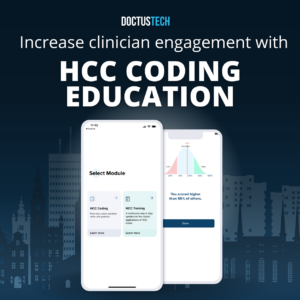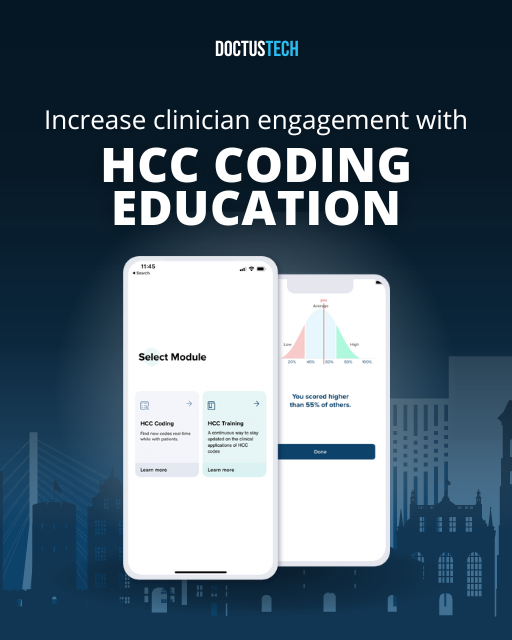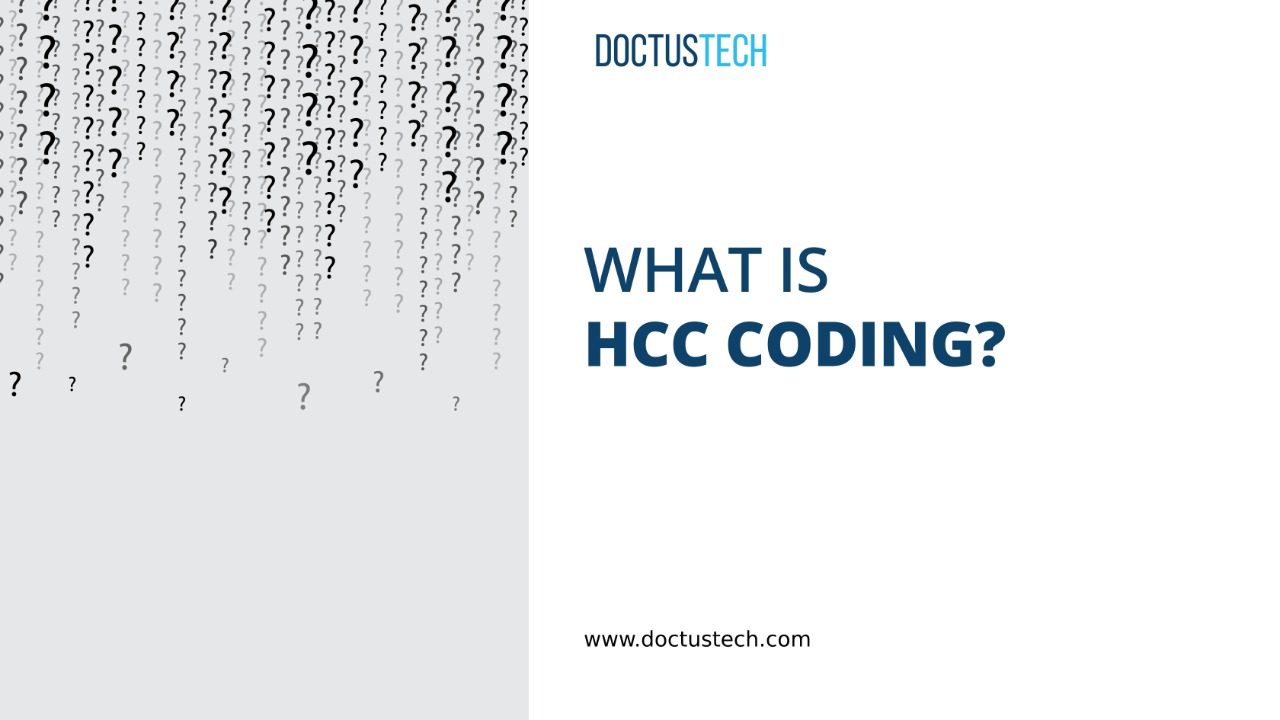Back in 2004, CMS introduced HCC coding as a tool to help estimate Medicare costs. Today, HCC coding us used across Medicare Advantage plans, the Medicare Shared Savings Program, Medicaid, and private health plans – all deploying a variation of the risk adjustment model in order to quantify the upcoming cost of care for their member population, and as a mechanism of submitting that care need to CMS for payment. And yet, the question comes up more often than you may think: “What is HCC Coding?”
Even in the value-based care space, there is confusion around HCC coding, which ICD10 codes risk adjust, and how to diagnose and document accurately and specifically. So if you’re moving from fee-for-service into VBC, taking on risk for the first time, or a veteran at HCC coding for VBC, this article will clarify much of the confusion and simplify what HCC coding is, why it matters, how it is used and what the future holds for HCC and VBC.
Do Doctors Know HCC Coding?
 First, clinicians typically have a good working knowledge of ICD-10 codes. And every org has their lookup functions baked into the EMR. However, not only do most ICD-10 codes not work as HCC codes, many of the traditional ways of diagnosing in the fee-for-service world are turned on their heads in VBC. So knowing or having access to ICD-10 codes is not actually that much of an advantage when learning HCC coding. In fact, in some cases, that knowledge can be a liability.
First, clinicians typically have a good working knowledge of ICD-10 codes. And every org has their lookup functions baked into the EMR. However, not only do most ICD-10 codes not work as HCC codes, many of the traditional ways of diagnosing in the fee-for-service world are turned on their heads in VBC. So knowing or having access to ICD-10 codes is not actually that much of an advantage when learning HCC coding. In fact, in some cases, that knowledge can be a liability.
Knowing the code to document diabetes is great, but using that same basic E11.9 that you’re used to is not helpful when diagnosing in a risk model. You need to dig into the complications, the severity of the disease state, and both diagnose and document with high specificity in order to treat and afford to treat the full complications of the disease. If you under-diagnose, you will likely under-treat, and risk an avoidable hospitalization, the risks to the patient and the costs notwithstanding. So in the case of diabetes, a quick check of the toes could yield a missed diagnosis that is critical to the patient’s care as well as accurate RAF and adequate capitation.
What are HCC Codes?
Hierarchical Condition Categories – as the name implies, the categories relate to a hierarchy of of conditions, and it all works together as an efficient sort function to calculate the risk that the patient’s will be expensive. Think about it like this: A patient with mild diabetes as unlikely to end up in the ER due to their disease, so basic diabetes does not risk adjust; whereas a patient with severe diabetes with complex circulatory symptoms that have already led to amputation of one toe is at extremely high risk of ending up in the ER, and they will require a lot of personal and intense care to keep them out of the hospital. And care costs money, so risk and care are nearly synonymous. A higher risk diagnosis gets an HCC code with a higher risk adjustment score, which adds a higher multiplier to the capitation of that patient – meaning the government pays more dollars a month to maintain that disease and help that patient stay out of the hospital.
How do clinicians use HCC coding?
The primary use of HCC codes is to document new chronic condition diagnoses, and recapture chronic conditions being treated, and communicate those diagnoses to Payors and CMS in order to receive capitated payments.
How do HCC codes translate to revenue?
 The payment model is obviously vastly different from the traditional fee-for-service (FFS) format where actions are performed, justified, transmitted as CPC codes and reimbursed by payors and/or CMS. In the VBC model, a patient is diagnosed with a specific chronic condition, that condition is documented and coded based on hierarchical condition categories that adjust the risk associated with keeping that patient healthy and out of the hospital. By taking on that risk, the plan or provider group is agreeing that, if given a reasonable amount of money, they will be able to maintain the health of that patient. That money directly ties back to the HCC codes documented, and is paid on a capitated model, with a certain dollar amount paid per-member per-month (PMPM). Those payments allow the overall organization to provide excellent care to the entire patient population, paying extra attention to those whose disease states have reached a complexity where significant resources are required to maintain optimal health. Whether for-profit or non-profit, the organization providing care will financially benefit from accurate diagnosis coding and aggressively proactive care.
The payment model is obviously vastly different from the traditional fee-for-service (FFS) format where actions are performed, justified, transmitted as CPC codes and reimbursed by payors and/or CMS. In the VBC model, a patient is diagnosed with a specific chronic condition, that condition is documented and coded based on hierarchical condition categories that adjust the risk associated with keeping that patient healthy and out of the hospital. By taking on that risk, the plan or provider group is agreeing that, if given a reasonable amount of money, they will be able to maintain the health of that patient. That money directly ties back to the HCC codes documented, and is paid on a capitated model, with a certain dollar amount paid per-member per-month (PMPM). Those payments allow the overall organization to provide excellent care to the entire patient population, paying extra attention to those whose disease states have reached a complexity where significant resources are required to maintain optimal health. Whether for-profit or non-profit, the organization providing care will financially benefit from accurate diagnosis coding and aggressively proactive care.
How does HCC coding help doctors get paid?
When done correctly, practicing medicine in a Value-Based Care arrangement means more time for doctors, less administrative burden, less burnout and more time to spend per-patient. Smaller panels, and more help treating patients mean that a good doctor can provide truly life-changing care to patients without over-working or over-coding. And by practicing good medicine with proper HCC documentation, you will find your organization flourishing and your patient outcomes improving – all while actually decreasing the overall cost of healthcare. Sure, there is no such thing as a perfect system, but this is as close as we can get in today’s environment. And with an eye to continuous improvement, good coding and good care puts your organization squarely on the path.
How does HCC coding translate to patient care?
You cannot treat what you do not diagnose. And if you diagnose with an eye to changing the trajectory of the patient’s care plan, you are practicing good medicine. To diagnose without proper documentation denies the patient the care that comes from critical revenue. And to document without care is, simply put, fraud. So diagnose with high specificity and proper documentation to ensure that your clinic can afford to provide the kind and quantity of care that will keep your VBC patients out of the hospital. Better HCC coding = better care.
How long does it take to learn HCC coding?
Depending on the tools used for teaching and learning, it can be a years-long process fraught with frustration and difficulty – OR – it can be a simple weekly check-in on an app that uses modern learning methodologies to make mastery quick and easy.
How does HCC coding relate to compliance audits?
 The number of compliance audits of provider groups has been steadily rising. The DOJ launches new lawsuits against both large payors and smaller provider groups with increasing penalties. And the Supreme Court has refused to step in and ease the pressure, letting whistle-blower cases proceed unchecked. Clinicians are doing their best, but that is no defense in an audit – the only thing that matters is facts, documentation, accuracy and pure compliance.
The number of compliance audits of provider groups has been steadily rising. The DOJ launches new lawsuits against both large payors and smaller provider groups with increasing penalties. And the Supreme Court has refused to step in and ease the pressure, letting whistle-blower cases proceed unchecked. Clinicians are doing their best, but that is no defense in an audit – the only thing that matters is facts, documentation, accuracy and pure compliance.
Practicing healthcare is an art, but documenting is a strict science, and anything less than accurate documentation vigorously maintained will likely result in negative audit outcomes and your group’s name landing in next month’s headlines.
CMS and DOJ have been increasingly scrutinizing payor strategies and billing patterns as it pertains to Hierarchical Condition Categories (HCCs). As more and more physician groups take on risk in the VBC models, it is imperative that physician groups do not make the same mistakes as their payor partners (intentionally or not).
Some of the most common offenses are fairly simple to avoid. But as we all know, simple does not mean easy. In fact, achieving simplicity can be far more difficult than creating complexity – which is what happens most of the time. A simple solution requires tremendous discipline.
HCC coding for acute conditions
As a rule of thumb, an acute code should not repeat 2 years in a row for a specific patient. And usually, even the first year is inaccurate. Acute heart attack is one of the most common errors penalized by CMS and the DOJ. One reason for this is misunderstanding how to document “history of heart attack” vs “heart attack.” Another version is chronic conditions that have been mis-coded as acute. There is a very short distance between upcoding and practicing good medicine.
It is sometimes appropriate to use these within the year where the acute event occurred, but the following year you must diagnose and document a different code. A third of the most common acute condition dinged by CMS is the combination of #1 & #2 – Acute Stroke and Acute Heart Attack.
Lack of clinical accuracy or supporting documentation – Medical diagnoses are complex and sometimes exist in the gray area between possibilities – but coding and compliance are hard rules. Picking the wrong code. Commonly misused diagnoses. While RADV audits are routinely looking for MEAT criteria, they’re not looking for clinical criteria or diagnostic accuracy.
Commonly misrepresented diagnoses: The exact criteria can be confusing even though the treatment can be the same for mild, moderate, and severe forms of certain diseases. Misrepresentation of the severity can result in overpayment from CMS, and legal and financial penalties – not to mention the obvious ethical concerns.
What is HCC Coding Without Plan of Care?
Now that a doctor has diagnosed a chronic condition, what is the plan to treat or manage the disease? A diagnosis that does not demonstrate a direct and deliberate impact on the plan of care is almost always incorrect at best, and in an audit, illegal. Diagnosing and documenting should function as a mechanism of providing care; documenting to document is never correct. So be on the lookout for conditions diagnosed and codes submitted that do not impact the plan of care. These are often targeted by CMS, both in OIG compliance audits and RADV audits.
How is HCC Coding improved by Education and 1-on-1 coaching?
 Build a culture that connects patient care to diagnostic specificity and accuracy in coding and documentation. No doctor wants the business managers coming down from their offices, clipboard in hand, scolding about how code capture and RAF scores impact revenue. But every clinician understands the need to improve care and decrease cost. So start there – in VBC, practicing good medicine and providing better care starts at accurate diagnosis right through to rigorous documentation.
Build a culture that connects patient care to diagnostic specificity and accuracy in coding and documentation. No doctor wants the business managers coming down from their offices, clipboard in hand, scolding about how code capture and RAF scores impact revenue. But every clinician understands the need to improve care and decrease cost. So start there – in VBC, practicing good medicine and providing better care starts at accurate diagnosis right through to rigorous documentation.
Documentation enables treatment, funds resources to provide care, ensures better health outcomes for patients and actually lessens clinician workload – when done correctly. Chart audits do not have to be brutal, they can be helpful, asking clinicians how a particular diagnosis changes the care trajectory, and helping document for maximum patient benefit. Internal meetings should focus on coding as care. And manual chart reviews should be performed by medical doctors to give timely 1-to-1 feedback. If this is done, the last error on the OIG’s list of usual suspects will go down:
How does HCC coding impact clinician workload?
It can go either way – with increased coding requirements becoming a burden, both to learn in boring seminars and to chase down in chart reviews. But with modern advanced app-based learning tools like DoctusTech, clinicians can master HCC coding in as little time as 5 minutes per week.
What is HCC coding to the OIG?
The Office of Inspector General of the Department of Health and Human Services is at the forefront of auditing healthcare fraud, and recommending action from the DOJ.
From OIG: Since its 1976 establishment, the Office of Inspector General (OIG) has been at the forefront of the Nation’s efforts to fight waste, fraud and abuse and to improving the efficiency of Medicare, Medicaid and more than 100 other Department of Health & Human Services (HHS) programs.
In today’s healthcare landscape, the OIG is finding value-based care to be a target-rich environment, with special focus placed on Medicare Advantage programs, as these allow a small action (documenting a chronic condition that does not actually exist) to multiply into a year of capitated payments to an organization. The simple act of up-coding a condition into something more complex than it should be or over-coding by documenting a chronic condition that does not exist results in thousands of dollars per year in fraudulent overpayments.
What is HCC coding to the DOJ?
While the Department of Justice is not directly concerned with healthcare, they are very concerned about medical fraud, which defrauds the government’s medicare programs, and in extension, the American people. Most often, the DOJ takes on whistleblower cases, where an individual from inside an organization shares insider information regarding acts of upcoding or overcoding that are both large and systemic. These whistleblowers stand to profit significant sums, at times earning up to 20% of the total settlement. And with the recent Sutter case settling at $90,000,000, the whistleblower could potentially take home $18 Million. The False Claims Act ensures that the federal government has a means of penalizing organizations and individuals who, through filing false claims, defraud the government. While this law has been in place since the 1800s, it is getting renewed attention as the DOJ discovers millions of dollars in false claims specifically in Medicare Advantage programs, as these allow an organization to bill CMS with very little scrutiny or oversight.
Top mis-used HCC codes
We address this in a report, feel free to request it HERE.
Also, codes most found in unlinked chart reviews, and subject to RADV audits are detailed in our white paper, found HERE.
What are the requirements for HCC coding documentation?
Generally referred to as the MEAT Criteria, here are the four things you must have to document an chronic condition with an HCC code:
M = Monitoring by ordering or referencing labs, imaging studies or other tests
E = Evaluation with a targeted part of the physical examination specific to a certain diagnosis
A = Assessment of the status, progression or severity of the diagnosis
T = Treatment with medication, surgery, lifestyle modification, or referral to a specialist.
What are the best HCC coding tools?
 |
What apps are available for learning, search, lookup, documentation? This may be a bit of a self-promoting softball, but if you haven’t checked out the DoctusTech app by now, you really should. Make time with a member of our team to see if the DT app is right for your team. Demo DoctusTech today. |
What is the best way to change physician behavior around HCC coding
Notes and insights from a study published by AJMC on how to change physician behavior. “The authors evaluated methods for implementing clinical research and guidelines, in order to change physician practice patterns, in surgical and general practice. They evaluated the effectiveness of different implementation methods.”
And as we have demonstrated through successful behavior change in physicians using our HCC coding education app, the most common solutions aren’t the most effective when it comes to ongoing positive change in physician behavior. Want to learn how to change physician behavior? Let’s dig a little deeper into a review of reviews, revealing some hard truths.
We’ve been saying for years, lectures do not work. Emails do not work. If you want to know how to change physician behavior on HCC coding, don’t take our word for it. The American Journal of Managed Care released a systematic review evaluating fourteen medical reviews in an effort to understand which interventions are most effective in changing physician behavior for the better and improving patient outcomes.
It is evident from their publication that the methods of intervention most commonly deployed in teaching doctors HCC coding are rarely able to create lasting change in physician behavior.
What is the best tool inside the EMR?
The DoctusTech Patient Data Analysis Platform (PDAP) is the premier tool for Value-Based Care, living inside the EMR and helping clinicians find and use the best HCC codes, track and manage care associated with chronic diagnoses, and learn which codes to use for which patients – all while reducing clinician workload. It helps readdress conditions diagnosed last year, significantly improving recapture rates. And it helps administrators see into the data by clinician, patient, clinic or by codes. Learn how the DoctusTech PDAP can help your patients and your doctors live happier, healthier lives. Demo DoctusTech today.






